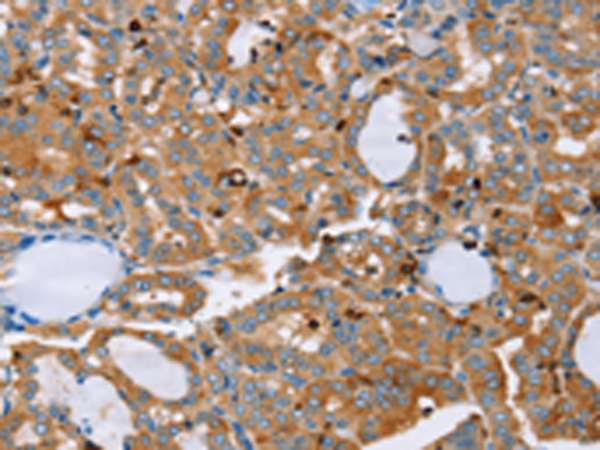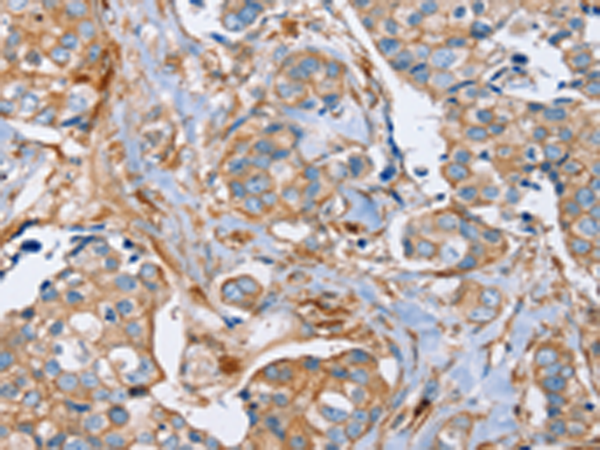


| WB | 咨询技术 | Human,Mouse,Rat |
| IF | 咨询技术 | Human,Mouse,Rat |
| IHC | 1/50-1/100 | Human,Mouse,Rat |
| ICC | 技术咨询 | Human,Mouse,Rat |
| FCM | 咨询技术 | Human,Mouse,Rat |
| Elisa | 1/5000-1/10000 | Human,Mouse,Rat |
| Aliases | BMND18; T-plastin |
| WB Predicted band size | 71 kDa |
| Host/Isotype | Rabbit IgG |
| Antibody Type | Primary antibody |
| Storage | Store at 4°C short term. Aliquot and store at -20°C long term. Avoid freeze/thaw cycles. |
| Species Reactivity | Human, Mouse, Rat |
| Immunogen | Fusion protein of human PLS3 |
| Formulation | Purified antibody in PBS with 0.05% sodium azide and 50% glycerol. |
+ +
以下是关于PARP2抗体的3篇参考文献,包含文献名称、作者及简要摘要内容:
---
1. **"Structural basis for DNA damage-dependent PARP activation by PARP2"**
*Authors: Ruf A, de Murcia G, Schulz GE*
**摘要**: 通过X射线晶体学解析了PARP2的DNA结合域结构,揭示了其与DNA损伤位点结合的分子机制,并阐明PARP2在DNA单链断裂修复中的特异性激活途径。
2. **"PARP1 and PARP2 stabilise replication forks by catalysing post-translational modifications"**
*Authors: Langelier MF, Zandarashvili L, Aguiar PM, et al.*
**摘要**: 研究利用特异性PARP2抗体进行免疫沉淀实验,证明PARP2与PARP1协同作用,通过催化多聚ADP核糖化修饰稳定停滞的DNA复制叉,防止基因组不稳定性。
3. **"Selective loss of PARG restores PARylation and counteracts PARP inhibitor-mediated synthetic lethality"**
*Authors: Hanzlikova H, Prokhorova E, Krejcikova K, et al.*
**摘要**: 通过PARP2抗体检测发现,PARP2缺失会增强PARP抑制剂(如奥拉帕尼)的敏感性,揭示了PARP2在调控PARP家族功能冗余及癌症治疗耐药性中的潜在作用。
---
以上文献涵盖PARP2的结构解析、功能研究及在治疗中的应用,均涉及PARP2抗体的实验验证。如需具体实验细节或扩展文献,可进一步补充关键词(如特定疾病或技术方法)。
PARP2 (Poly [ADP-ribose] polymerase 2) is a nuclear enzyme belonging to the PARP family, which plays a critical role in DNA repair, genomic stability, and cellular stress responses. It catalyzes the transfer of ADP-ribose units from NAD⁺ to target proteins, forming poly(ADP-ribose) (PAR) chains that facilitate DNA damage repair processes, particularly base excision repair (BER) and the resolution of DNA single-strand breaks. PARP2 shares functional overlap with PARP1 but exhibits distinct structural features, including a shorter N-terminal DNA-binding domain, which may confer specialized roles in chromatin remodeling, transcriptional regulation, and mitotic progression.
PARP2-specific antibodies are essential tools for studying its expression, localization, and molecular interactions. They are widely used in techniques like Western blotting, immunofluorescence, and immunohistochemistry to investigate PARP2's involvement in diseases such as cancer, neurodegenerative disorders, and inflammatory conditions. Research highlights PARP2's dual role in promoting cell survival via DNA repair while also contributing to PARP inhibitor resistance in cancer therapy. Antibodies targeting PARP2 help elucidate its crosstalk with other DNA repair proteins (e.g., XRCC1. BRCA1/2) and its impact on therapeutic responses, including sensitivity to PARP inhibitors like olaparib.
Recent studies emphasize PARP2's emerging roles beyond DNA repair, such as modulating mitochondrial function and metabolic pathways. Validated PARP2 antibodies are critical for distinguishing its activity from PARP1 in complex biological contexts, aiding both basic research and preclinical drug development.
×